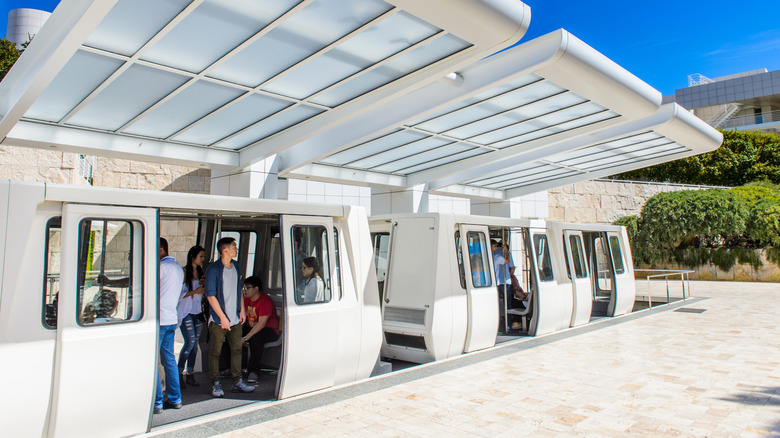This Bizarre Hovertrain Technology Was Ahead Of Its Time
The hovertrain was a revolutionary idea that was tested in the 1960s and '70s in a few countries but was later abandoned and never became a reality. Like Elon Musk's proposed hyperloop of today, the hovertrain was touted as a futuristic solution for faster and more efficient travel.
If you think the term has a familiar ring, it's because it was based on the hovercraft, the amphibious vehicle that uses an air cushion to glide over land or sea. The hovertrain used a cushion of magnets to propel it forward rather than traditional steel wheels, and it needed special guideways to be built for it. Additionally, the hovertrain was supposed to have been much faster than a typical train and could have reached speeds up to 300 mph (via The Daily Mail). But alas, this train never arrived. Let's dive in to see what happened and why it became the fastest train to have never been built.
Where did it all begin?
To understand why the world needed a hovertrain in the first place, you first need to understand the events that were happening at the time to get some context. During the 19th century, there were no planes, and cars had still not been invented yet. So, trains were the fastest mode of transportation to get where you needed to go. The advent of automobiles and planes turned the railway industry on its head and saw the popularity of trains wane as more people opted to use faster transportation. Even the fastest steam locomotive in 1938 could not compare to commercial flights and cars when it came to comfort, convenience, and of course, speed.
Another fallback that created a need for a different type of technology for trains was their wheels. Train wheels are somewhat conically shaped, which works efficiently by helping the train go around a bend. But, if a train reaches higher speeds, its cone-shaped wheels could create an effect called hunting oscillation which can cause it to derail. So, railway companies in countries like the United States needed a viable alternative that could compete with other available forms of transportation.
No one followed through with the idea
The first hovertrain was invented by Jean Bertin, a French engineer in the 1960s. It was developed for years before it was finally abandoned by the French government when they decided to invest in the TGV, France's first high-speed railway line (via Fabric of Paris). They were not the only country that was working on this technology, though. Both Britain and the United States were separately planning to launch their own prototypes of the hovertrain.
In Britain, scientists designed a hovertrain dubbed the RTV 31 that used a linear induction motor to power it. According to Foreign Policy, they intended for the train to travel from London to Glasgow in only two hours, which was three times faster than what trains could travel at the time. They got as far as establishing a company and testing the train, but the project was ditched in 1973 when the British government decided that the project was too expensive to invest in (via The Daily Mail). Around the same time, scientists in the United States were developing experimental hovertrains in Pueblo, Colorado, but the idea never took off.
Although a high-speed hovertrain has never been built, there are fast bullet trains that were developed and launched in different countries around the world. For example, one of the fastest trains in the world is Japan's Shinkansen train which speeds clocks in at a record-breaking 360 kilometers per hour, or 224 mph (via CNN).


